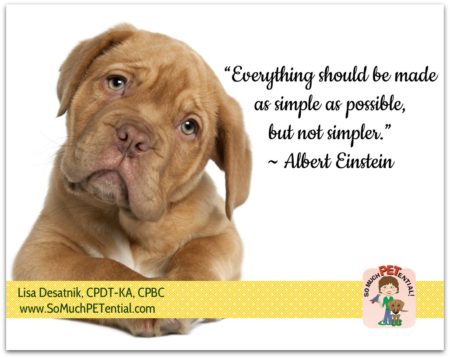“Everything should be made as simple as possible, but not simpler.” ~ Albert Einstein
I love this quote. In its great simplicity, it speaks volumes for both effective teaching and learning. This, from a world famous, brilliant physicist known for his general theory of relativity and recognized with a 1921 Nobel Prize.
 I think about this often when I am doing dog training and behavior consulting. A question foremost in my mind is always, ‘how can I help my student succeed with this lesson?”
I think about this often when I am doing dog training and behavior consulting. A question foremost in my mind is always, ‘how can I help my student succeed with this lesson?”
If the lesson is too difficult student frustration can lead to poor motivation, and with poor motivation focus on the teacher can quickly evaporate. When that occurs, teaching – at least teaching what we WANT our student to learn – is often not effective.
It is important to remember that in order for us to teach a behavior and strengthen its future rate, we first need to ‘get’ the behavior to occur so that we can follow that behavior with a reinforcing consequence. I continue to remember observing in a two day class with reknown trainer Dave Kroyer a session where he was coaching another trainer on teaching her dog to put his nose in a hole of a scent box. There was a moment when her dog was not ‘getting it’ and began pawing at the box. Dave’s response was to pick the box up and ask the trainer what they could do to help her dog understand. The answer was to put the box on its side. With that small change, her dog immediate went to the open hole and placed his nose inside.
And, once you and your student have success, then you can build upon that success from there by incrementally adding to the behavior as your learner can continue to succeed.
What are some ways in which you can make your lesson plan as simple as possible but not simpler?
For one, begin teaching in an environment with minimal other distractions. It is hard enough to focus on learning something new. With stimulus going on around you, it is that much more difficult to focus. Please read this column I had written on the importance of decluttering the teaching classroom.
Break the behavior down into small steps or approximations, and reinforcing your learning after each behavior approximation toward the final behavior. This is known as shaping, and it is a lot of fun to practice. Please click here to read a past post about it.
Be aware of the importance of timing when it comes to teaching new behaviors. Contiguity refers to the closeness in time between the behavior and its consequence while contingency refers to the degree of correlation between the behavior and its consequence (*if* I do this behavior, *the* this is the consequence that will follow). The less time there is between the behavior and its consequence, the quicker and easier the animal can build that relationship. Please click here to read more. The immediacy with which you can ‘click’ and mark a correct behavior is one of the reasons why clicker training is so effective.
Use reinforcers that are of value to your learner. Remember, it is the learner that gets to decide what is of greatest value to him/her and that can change throughout a day. Learners will always choose to do the behavior that gets them a consequence of the greatest value to them so plan ahead and make sure you’ve stacked the deck in your favor. You can read more in this post.






